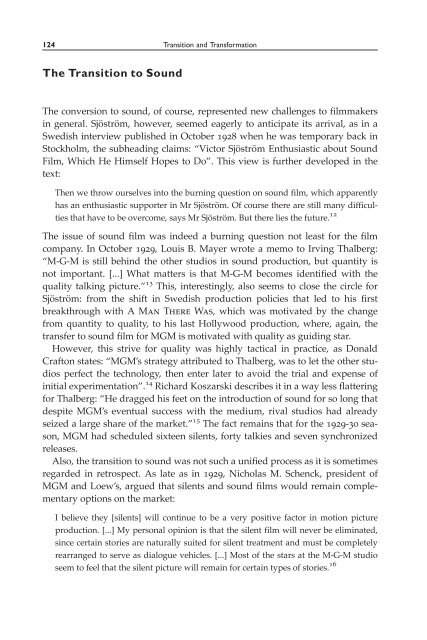FILM FILM - University of Macau Library
FILM FILM - University of Macau Library
FILM FILM - University of Macau Library
You also want an ePaper? Increase the reach of your titles
YUMPU automatically turns print PDFs into web optimized ePapers that Google loves.
124 Transition and Transformation<br />
The Transition to Sound<br />
The conversion to sound, <strong>of</strong> course, represented new challenges to filmmakers<br />
in general. Sjöström, however, seemed eagerly to anticipate its arrival, as in a<br />
Swedish interview published in October 1928 when he was temporary back in<br />
Stockholm, the subheading claims: “Victor Sjöström Enthusiastic about Sound<br />
Film, Which He Himself Hopes to Do”. This view is further developed in the<br />
text:<br />
Then we throw ourselves into the burning question on sound film, which apparently<br />
has an enthusiastic supporter in Mr Sjöström. Of course there are still many difficulties<br />
that have to be overcome, says Mr Sjöström. But there lies the future. 12<br />
The issue <strong>of</strong> sound film was indeed a burning question not least for the film<br />
company. In October 1929, Louis B. Mayer wrote a memo to Irving Thalberg:<br />
“M-G-M is still behind the other studios in sound production, but quantity is<br />
not important. [...] What matters is that M-G-M becomes identified with the<br />
quality talking picture.” 13 This, interestingly, also seems to close the circle for<br />
Sjöström: from the shift in Swedish production policies that led to his first<br />
breakthrough with A Man There Was, which was motivated by the change<br />
from quantity to quality, to his last Hollywood production, where, again, the<br />
transfer to sound film for MGM is motivated with quality as guiding star.<br />
However, this strive for quality was highly tactical in practice, as Donald<br />
Crafton states: “MGM’s strategy attributed to Thalberg, was to let the other studios<br />
perfect the technology, then enter later to avoid the trial and expense <strong>of</strong><br />
initial experimentation”. 14 Richard Koszarski describes it in a way less flattering<br />
for Thalberg: “He dragged his feet on the introduction <strong>of</strong> sound for so long that<br />
despite MGM’s eventual success with the medium, rival studios had already<br />
seized a large share <strong>of</strong> the market.” 15 The fact remains that for the 1929-30 season,<br />
MGM had scheduled sixteen silents, forty talkies and seven synchronized<br />
releases.<br />
Also, the transition to sound was not such a unified process as it is sometimes<br />
regarded in retrospect. As late as in 1929, Nicholas M. Schenck, president <strong>of</strong><br />
MGM and Loew’s, argued that silents and sound films would remain complementary<br />
options on the market:<br />
I believe they [silents] will continue to be a very positive factor in motion picture<br />
production. [...] My personal opinion is that the silent film will never be eliminated,<br />
since certain stories are naturally suited for silent treatment and must be completely<br />
rearranged to serve as dialogue vehicles. [...] Most <strong>of</strong> the stars at the M-G-M studio<br />
seem to feel that the silent picture will remain for certain types <strong>of</strong> stories. 16

















